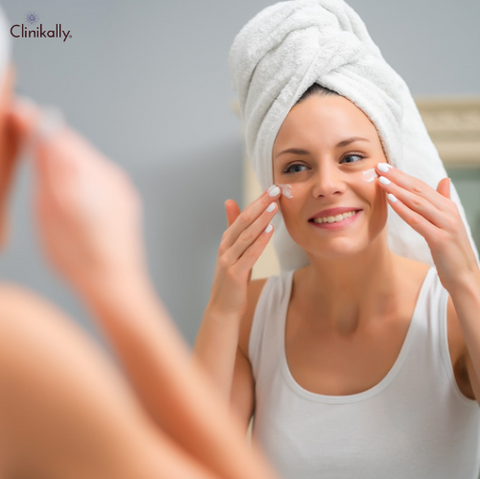Witch hazel is a potent botanical extract that has been used for centuries for its skin benefits. Simply apply witch hazel to your skin with a cotton pad or ball. After cleansing your skin, you can also use it as a toner. To avoid drying out your skin, look for alcohol-free witch hazel. Many skincare products, including toners, cleansers, and moisturisers, contain witch hazel.
What is Witch Hazel? Understanding the Origins and Properties

Witch hazel is a botanical extract derived from the leaves and bark of the Hamamelis virginiana (witch hazel) shrub. The plant is native to North America, and Native Americans have used it for centuries for its medicinal properties. Witch hazel extract is made by steaming the plant's leaves and bark, which releases the plant's natural oils and tannins. The liquid that results is then distilled to produce a concentrated extract. Witch hazel has several skin-beneficial properties, including:
-
Anti-inflammatory: Witch hazel's inborn anti-inflammatory qualities can help calm and lessen skin inflammation.
-
Astringent: Witch hazel is a naturally occurring astringent that can aid in pore tightening and minimise the appearance of large pores on the skin.
-
Antimicrobial: Witch hazel naturally combats microorganisms, assisting in the prevention of skin infections and the death of bacteria.
-
Moisturising: Witch hazel contains natural oils that can help moisturise and hydrate the skin.
-
Antioxidant: Antioxidants found in witch hazel can help shield the skin from oxidative stress and early ageing.
The Historical Uses and Folklore Behind Witch Hazel
Witch hazel has a long history of use in folklore and traditional medicine. Here are some historical and folklore uses for witch hazel:
-
Native American Medicine: Witch hazel has long been used medicinally by Native Americans. They used it to treat tumours as well as muscle aches and skin irritations.
-
Colonial America: Wounds, bruises, and haemorrhoids were just a few of the ailments that witch hazel was used to treat. The treatment of insect bites and use as an insect repellent were also practised.
-
Folk Medicine: Diarrhoea, fever, and menstrual cramps have all been treated using witch hazel in folk medicine.
-
Spiritual Uses: Witch hazel was used for spiritual purposes in some cultures. Witch hazel was thought to be a powerful plant that could ward off evil spirits and protect against negative energy by the Cherokee.
-
Magic and Witchcraft: Witch hazel was thought to have magical properties in European folklore. It was believed to have the power to heal and protect against evil spirits and was used in spells and potions.
The Astringent and Anti-Inflammatory Properties of Witch Hazel
Witch hazel is a well-liked ingredient in many skincare products due to its well-known anti-inflammatory and astringent properties. These properties work as follows:
-
Astringent properties: Witch hazel is a natural astringent, which means it can contract or tighten tissues. When applied to the skin, witch hazel can help shrink pores and reduce the appearance of fine lines and wrinkles. It also can reduce oil production, making it an ideal ingredient for those with oily or acne-prone skin. Witch hazel is a popular ingredient in toners and facial mists due to its astringent properties, which can help balance and tone the skin.
-
Anti-inflammatory properties: Witch hazel also has anti-inflammatory properties, so it can help reduce skin redness, swelling, and inflammation. This makes it an excellent ingredient for people who have sensitive or irritated skin, as well as those who suffer from inflammatory skin conditions such as acne, eczema, and rosacea. The anti-inflammatory properties of witch hazel are due to its high tannin content, which has been shown to have an astringent and anti-inflammatory effect on the skin.
Witch Hazel and Acne-Prone Skin: A Natural Toner Solution
Witch hazel is a natural astringent with medicinal properties that have been used for centuries. It's a great natural toner for acne-prone skin because it helps to reduce inflammation, tighten pores, and remove excess oil. To use witch hazel as a natural toner for acne-prone skin, follow these steps:
-
A natural health store or online retailer should sell you pure, alcohol-free witch hazel extract.
-
Apply a small amount of witch hazel to a cotton pad and gently wipe your face after cleansing it with a mild cleanser.
-
Pay special attention to your T-zone (forehead, nose, and chin), which is prone to acne.
-
Before using any moisturiser or other skincare products, let the witch hazel completely dry.
-
Depending on the requirements of your skin, repeat this procedure once or twice daily.
The Healing Properties of Witch Hazel: Skin Irritation, Sensitivity, and Puffiness

Witch hazel has a long history of anti-inflammatory use, especially in the management of skin sensitivity, irritation, and puffiness. It contains tannins, which are astringent and can help tighten and soothe the skin. Here are a few ways to use witch hazel to help with these issues:
-
Skin Irritation: Witch hazel can help to calm and soothe the skin if it is irritated, such as from insect bites, sunburn, or razor burn. Use a cotton ball and a small amount of witch hazel to gently apply the solution to the affected area.
-
Skin Sensitivity: Witch hazel can help to lessen redness and irritation if you have sensitive skin. Apply witch hazel to your skin before bed by combining it with a carrier oil like jojoba or almond.
-
Puffiness: Witch hazel can also aid in the reduction of puffiness around the eyes. To reduce inflammation and soothe the skin, soak cotton pads in witch hazel and place them over your eyes for a few minutes.
Soothe Your Skin: Witch Hazel for Irritation and Sensitivity
Witch hazel is a natural remedy for soothing skin irritation and sensitivity. Its astringent properties can shrink pores and reduce inflammation, while its anti-inflammatory and antioxidant properties can calm the skin and provide protection. Here are some ways to soothe your skin with witch hazel:
-
Sunburn: Witch hazel can help to lessen the discomfort and swelling brought on by sunburn. Witch hazel can be applied to a cotton pad with a small amount of witch hazel and then gently dabbed onto the affected area.
-
Razor Burn: Witch hazel can also be used to relieve razor burns. After shaving, apply witch hazel to the affected area to help reduce redness and irritation.
-
Eczema and psoriasis: Witch hazel can be utilised to relieve the signs and symptoms of eczema and psoriasis. Witch hazel can be applied to the affected area to help reduce inflammation and soothe the skin by combining it with carrier oil, such as coconut or jojoba oil.
-
Allergic Reactions: Witch hazel can also be used to treat allergic reactions like hives or rashes. To relieve itching and irritation, apply a small amount of witch hazel to the affected area.
Puffiness Be Gone: Witch Hazel as an Anti-Inflammatory
Witch hazel is a natural anti-inflammatory that can help with skin puffiness and inflammation. It contains tannins, which are astringent and can help tighten and soothe the skin. Here are some ways to reduce puffiness with witch hazel:
-
Under-Eye Puffiness: Witch hazel can aid in the reduction of puffiness around the eyes. To reduce inflammation and soothe the skin, soak cotton pads in witch hazel and place them over your eyes for a few minutes.
-
Insect Bites: Witch hazel can also be used to treat insect bites and reduce swelling and inflammation. Apply a small amount of witch hazel to a cotton pad and gently dab it onto the affected area.
-
Skin Irritation: Witch hazel can also aid in minimising puffiness brought on by skin irritability. To help reduce inflammation and calm the skin, apply witch hazel to the affected area.
-
Sunburn: Witch hazel can also help lessen the puffiness brought on by sunburn. Apply witch hazel to the affected area to help reduce inflammation and soothe the skin.
Dark Circles: Witch Hazel's Secret Weapon to Reducing Puffiness
Witch hazel can help reduce puffiness around the eyes, which can reduce the appearance of dark circles. The skin can be tightened and soothed by witch hazel's astringent properties, and swelling and puffiness can be lessened by the herb's anti-inflammatory properties. Here are some ways to reduce puffiness and dark circles with witch hazel:
-
Place cotton pads that have been dipped in witch hazel over your closed eyes for ten to fifteen minutes. Inflammation and puffiness may be lessened as a result.
-
Apply witch hazel to the under-eye area before bed after combining it with a few drops of almond or coconut oil. The skin will be soothed, and the puffiness will be reduced.
-
Witch hazel and cool water can be combined to make a compress, which you should apply to your eyes for a few minutes. This may lessen inflammation and calm the skin.
While witch hazel is generally thought to be safe, it can still cause irritation or allergic reactions in some people. Always perform a patch test on a small area of skin before applying it to a larger area, and discontinue use if any adverse reactions occur. Additionally, because dark circles can be brought on by a variety of factors, witch hazel may not completely get rid of them, even though it can help to minimise their appearance.
Witch Hazel for Skincare: Hydration, Protection, and Anti-Aging

Witch hazel has hydrating, anti-aging, and protective qualities, making it a fantastic addition to your skincare regimen. The following are some skincare applications for witch hazel:
-
Hydration: To help hydrate the skin, witch hazel can be used as a natural toner. Its astringent and moisturising properties can help to tighten pores and reduce oiliness, while its astringent and moisturising properties can help to keep the skin hydrated. After cleansing, apply witch hazel to a cotton pad and gently swipe it over your face.
-
Protection: Witch hazel contains antioxidants that can help protect the skin from free radical damage. Free radicals are unstable molecules that can harm the skin and accelerate the ageing process. Witch hazel can help protect your skin from these harmful molecules.
-
Anti-Aging: Witch hazel can aid in the reduction of fine lines and wrinkles. Its astringent properties can tighten the skin and reduce sagging, while its antioxidant properties can protect the skin from damage that can cause premature ageing.
-
Acne Treatment: Acne-prone skin can benefit from the use of witch hazel. Its astringent properties can help to tighten pores and reduce oiliness, while its anti-inflammatory properties can help to reduce acne-related redness and inflammation.
Hydrate and Balance: How Witch Hazel Keeps Your Skin Moisturized
Witch hazel can help keep your skin hydrated and balanced by acting as a natural toner. Its astringent properties can help to tighten pores and reduce oiliness, while its moisturising properties can help to keep the skin hydrated. Here are some ways to use witch hazel to keep your skin moisturised:
-
Natural Toner: Witch hazel can be used as a natural toner to balance the pH levels of the skin and keep it moisturised. After cleansing, apply witch hazel to a cotton pad and gently swipe it over your face.
-
DIY Face Mist: You can make your face mist at home with witch hazel and other hydrating ingredients like rosewater or aloe vera. Pour witch hazel into a spray bottle along with equal parts rosewater or aloe vera gel. To keep your face moisturised throughout the day, mist it with liquid.
-
Acne Treatment: Witch hazel can also help to moisturise acne-prone skin. Its astringent properties can help to tighten pores and reduce oiliness, while its anti-inflammatory properties can help to reduce acne-related redness and inflammation.
Protection from the Sun: How Witch Hazel Extract Can Shield Your Skin
While witch hazel is not a replacement for sunscreen, it does contain natural tannins and antioxidants that can help protect the skin from sun damage. Here are some of the ways witch hazel can protect your skin from the sun:
-
Witch hazel contains antioxidants that can help protect the skin from free radical damage. Free radicals are unstable molecules that can harm the skin and accelerate the ageing process. Witch hazel can help protect your skin from these harmful molecules.
-
Sunburned skin can be soothed and calmed with witch hazel. Its anti-inflammatory and astringent properties can help to tighten and tone the skin.
-
As part of an after-sun care routine, witch hazel can be used to soothe and protect the skin. To soothe and protect the skin, apply witch hazel to a cotton pad and gently swipe it over sun-exposed areas.
Say Goodbye to Blemishes and Aging Skin: Witch Hazel as a Non-Drying Antioxidant
Witch hazel is a non-drying antioxidant that can aid in the reduction of blemishes and the appearance of ageing skin. Here are some examples of how you can use witch hazel for these purposes:
-
Acne Treatment: Acne-prone skin can benefit from the use of witch hazel. Its astringent properties can help to tighten pores and reduce oiliness, while its anti-inflammatory properties can help to reduce acne-related redness and inflammation. Its antioxidant properties can also help protect the skin from damage that can cause blemishes.
-
Anti-Aging: Witch hazel can aid in the reduction of fine lines and wrinkles. Its astringent properties can tighten the skin and reduce sagging, while its antioxidant properties can protect the skin from damage that can cause premature ageing.
-
DIY Face Mask: Make your face mask with witch hazel and other natural ingredients like honey, avocado, or turmeric. Make a paste of witch hazel and your chosen ingredients and apply it to your face. Allow the mask to sit for 10-15 minutes before removing with warm water. This can aid in the reduction of blemishes and the promotion of a more youthful appearance.
Incorporating Witch Hazel into Your Skincare Routine: Tips and Tricks

Here are some ways to incorporate witch hazel into your skincare routine:
-
Start Slowly: It's best to start slowly and incorporate witch hazel into your skincare routine if you've never used it before. Use it once a day to start, and as your skin adjusts, use it more frequently.
-
Use as a Toner: Witch hazel is an effective toner that can be used after cleansing to help balance the pH levels of the skin and remove any remaining impurities. Simply apply witch hazel to a cotton pad and gently swipe it over your face.
-
Mix with Other Ingredients: Rosewater, aloe vera, or tea tree oil can all be added to witch hazel to improve its effects. For instance, mixing witch hazel with rosewater creates a toner that is hydrating, while mixing it with tea tree oil creates a toner that fights acne.
-
After-Sun Care: Witch hazel can be used to calm sunburned skin. Witch hazel can be applied to a cotton pad and gently rubbed over exposed skin.
-
Moisturise After Use: Witch hazel can be slightly drying, so it's important to follow up with a moisturiser after use. This will help to keep your skin hydrated and balanced.
-
Choose a High-Quality Product: When shopping for witch hazel, look for a high-quality product that is free of alcohol and other harsh chemicals. Look for "distilled" or "alcohol-free" products to ensure that they are gentle and non-drying.
-
Patch Test: As with any new skincare product, a patch test on a small area of skin is recommended before using it on a larger area. This will help ensure that you have no negative reactions to the product.
Finding the Right Witch Hazel Product for Your Skin Type
When selecting a witch hazel product, keep your skin type and specific skincare needs in mind. Here are some pointers to help you find the best witch hazel product for your skin:
-
For oily or acne-prone skin: Look for a witch hazel product that is formulated specifically for oily or acne-prone skin. These products may also contain acne-fighting ingredients such as salicylic acid or tea tree oil.
-
For dry or sensitive skin: Choose a witch hazel product that is formulated to be gentle and non-drying. Look for products that are labelled as "alcohol-free" or "distilled" and contain additional hydrating ingredients like aloe vera or chamomile.
-
For anti-aging benefits: Look for witch hazel products that include antioxidants such as vitamin E or green tea extract, as these can help protect against damage that can lead to premature ageing.
-
For after-sun care: Select a witch hazel product that contains additional soothing ingredients, such as lavender or chamomile, to help calm and hydrate sun-exposed skin.
-
For a DIY approach: Consider buying pure witch hazel extract or hydrosol and combining it with other natural ingredients to make your customised skincare products.
Proper Usage of Witch Hazel in Your Skincare Regimen
Witch hazel is a versatile skincare ingredient with numerous applications. Here are some pointers on how to incorporate witch hazel into your skincare routine:
-
Use witch hazel as a toner: After cleansing, use witch hazel as a toner to help balance the pH levels of the skin and get rid of any impurities that may still be present. Witch hazel should be applied to a cotton pad, then gently rubbed over your face.
-
Apply witch hazel as a spot treatment: Witch hazel can be used as a spot treatment for blemishes or inflamed areas. Simply apply a small amount of witch hazel to a cotton swab and dab it onto the affected area.
-
Use it as an after-sun care: Witch hazel can be used to soothe sunburned skin. Simply apply witch hazel to a cotton pad and gently swipe it over sun-exposed areas.
-
Combine it with other ingredients: Witch hazel can be enhanced by combining it with other natural ingredients such as rosewater, aloe vera, or tea tree oil. For example, combining witch hazel with rosewater yields a hydrating toner, whereas combining it with tea tree oil yields an acne-fighting toner.
-
Follow up with a moisturiser: Witch hazel can be slightly drying, so it's important to follow up with a moisturiser after use. This will help to keep your skin hydrated and balanced.
-
Use it regularly: For best results, incorporate witch hazel into your skincare regimen regularly. Depending on your skin's needs, you may choose to use witch hazel once or twice a day.
The Importance of pH Balance When Using Witch Hazel

Maintaining your skin's pH balance is critical for healthy skin. The natural pH of the skin is around 5.5, which is slightly acidic and protects the skin from harmful bacteria and environmental stressors. When incorporating witch hazel into your skincare routine, keep its pH in mind. Witch hazel has a pH level of around 5, which is slightly acidic and similar to the pH level of the skin. This means that using witch hazel can aid in the maintenance of the skin's natural pH balance and the maintenance of healthy skin. It is important to note, however, that not all witch hazel products are created equal. The additional ingredients in some products, like alcohol, may disrupt the pH balance of the skin and result in dryness or irritation. When selecting a witch hazel product, look for one that does not contain alcohol or other harsh ingredients.








































